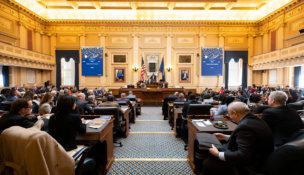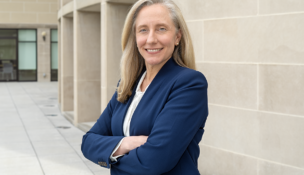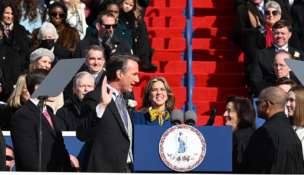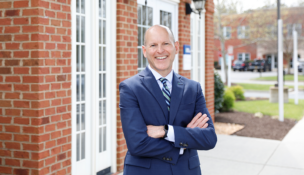Landing Amazon
Virginia’s education investments made its HQ2 incentives package stand out
Landing Amazon
Virginia’s education investments made its HQ2 incentives package stand out
Stephen Moret had just finished speaking to the annual meeting of the Virginia Association of Counties at The Omni Homestead Resort in Hot Springs when his phone buzzed just before 11 a.m. The text said: “We’d like to sign today. What time can you talk?”
Moret, president and CEO of the Virginia Economic Development Partnership, was the lead negotiator behind Virginia’s effort to win Amazon’s $5 billion second headquarters, a once-in-a-generation prize that initially promised as many as 50,000 jobs.
The previous Thursday, Nov. 8, he sent Amazon a final draft of Virginia’s incentives package. The follow-up text on Nov. 12, a Monday, was a positive sign.
“Yes. We can sign right away,” Moret texted back.
A conference call was set for 2 p.m. Moret and his colleagues hit the road, driving through mountainous Bath County on their way to Northern Virginia in case the big news broke. An Amazon attorney emailed him the agreement at 12:34 p.m. “I had one of those mobile, Wi-Fi hotspot things, but when you are in rural Virginia, the service is in and out,” says Moret.
When his signal dropped from three bars to zero, the irony wasn’t lost on Moret. His own technology was failing at the moment he was trying to seal the “deal of the century” with a tech giant.
He stopped the car and opened the door to improve the signal. Moret reviewed the document, signed it electronically, and hit send. “The first time we submitted it, it didn’t go through. It was stressful,” he says.
On another try, the document — also signed electronically by Secretary of Commerce and Trade Brian Ball — successfully transmitted at 12:45 p.m. Four minutes later, Amazon sent back a signed memorandum of understanding (MOU) for one of the most sought-after corporate investments in U.S. history.
Shortly before 2 p.m., Moret’s car pulled into a Wendy’s for lunch in Verona, near Staunton in the Shenandoah Valley. While the others went in for burgers, Moret stayed in the car for the conference call.
It was official. On the call, Moret, Ball and other officials learned Seattle-based Amazon would locate half of its headquarters in Arlington County and Alexandria, bringing 25,000 jobs, an investment of $2.5 billion and the leasing of 4 million square feet. The other half of the headquarters was headed to Queens in New York City, but the second location wasn’t revealed on the call.
Gov. Ralph Northam and Amazon announced the headquarters decision the next day, ending 14 months of wild speculation on where the e-commerce and cloud computing giant would land. The competition sparked a fierce bidding war with 238 localities vying for what came to be known as HQ2.
While the hunt is over, a new and transformative chapter is beginning in Virginia, say state officials and business leaders. They expect the deal to change Virginia from a slow-growth state — too long dependent on federal government contracts — into a fast-growth technology leader.
In addition to Amazon’s 25,000 high-paying jobs, a report by Richmond-based Chmura Economics & Analytics predicts the ripple effects of the project will create another 33,687 jobs and have an annual economic impact of $14.2 billion by 2030. By that time, the Amazon headquarters could generate $346.7 million annually in state revenues.
If implemented as envisioned, Moret says, HQ2 would generate at least 15 to 25 percent of the additional jobs needed for Virginia to regain a top-10 state ranking in economic growth. For the past five years, the commonwealth has ranked No. 30 among the 50 states. Moret also expects the project to keep thousands more college graduates in Virginia — reversing an out-migration trend.
“Here’s this huge, private sector- focused tech opportunity across multiple sectors. Amazon is not just a web retailer. This is unmanned systems, robotics, artificial intelligence. There are so many businesses they are getting into,” he says.
Amazon also has a growing presence in cloud computing and is competing for more federal contracts. The state’s MOU with the company includes a clause limiting the number of new jobs at the headquarters that can be focused on the public sector. If more than 10 percent of the jobs are primarily engaged in supporting federal government contracts, then the state will reduce any grant incentive payments for that calendar year.
Education incentives key
While some regions dangled goodies like Amazon-only executive lounges at busy airports, the hallmark of Virginia’s incentive package was a $1.1 billion investment in higher education during the next 20 years. That commitment is expected to greatly expand the pipeline of tech talent, benefiting not only Amazon but the state’s entire technology sector.
Virginia’s focus on deveoping a talent pipeline “did make the proposal stand out,” says Holly Sullivan, Amazon’s director of worldwide economic development, who led the company’s site selection team. Sullivan told Virginia Business, “We looked at the talent from day one: what’s here, how to build the talent pipeline and the migration of people moving into the region to see what those skill sets were.”
The state plans to spend $710 million to double the annual number of bachelor’s and master’s degrees conferred in computer science and related fields during the next two decades.
Virginia Tech, which already had plans to expand in Northern Virginia, agreed to establish a $1 billion Innovation Campus at Alexandria’s Potomac Yard. The commonwealth and the university each will kick in $250 million for the project. The education initiative also includes $125 million for the expansion of George Mason University’s campus in Arlington.
In terms of direct cash incentives, Virginia offered a total of $573 million, considerably less than the $1.5 billion in subsidies offered by New York. The commonwealth’s direct incentives include $550 million, or $22,000 per job. Amazon is eligible for another $200 million in grants if it creates an additional 12,850 jobs in a second phase of development.
The grants would be paid four years after the jobs are created so that additional tax revenues could be generated by Amazon to cover the cost.
Arlington offered a performance cash grant of $23 million over 15 years based on incremental growth of an existing tax on hotel rooms.
Besides jobs and education, the incentives focused on housing and traffic concerns that could result from the project. Arlington and Alexandria plan to fund more than $570 million in transportation projects serving Amazon’s newly branded National Landing site, which includes Crystal City, the eastern part of Pentagon City and Potomac Yard.
The two localities also plan to use tax revenues generated by Amazon to make annual investments of $15 million during the next decade to create and preserve 2,000 to 2,400 units of affordable housing.
The state’s package offers $195 million of non-general fund money for five multimodal transportation projects, including additional entrances to Metro stations at Crystal City and Potomac Yard.
Asked about the importance of incentives in the search, Sullivan says, “The way we approached incentives for this project was: ‘How can we utilize them to invest in our workforce and to invest in the real estate side to create an innovative development with open space and opportunities?’”
While reaction to the HQ2 deal has been primarily positive, there are some critics, including Del. Lee Ware, R-Powhatan, the General Assembly’s House Finance Committee chair and a former member of a state legislative commission that reviews state financing for major economic development projects.
Ware was so strongly opposed to Amazon subsidies that he resigned from the Major Employment and Investment Project Approval Commission (MEI) in February. “I believe the scale of the governmental incentives and subsidies for both the commonwealth and Northern Virginia localities is imprudent given the fragility of the economy, the mounting pressure to both the state and federal budgets posed by expansion of Medicaid coverage and the fact that Amazon is a huge corporation headed by the wealthiest individual in the world,” Ware said in an email to Virginia Business.
Vote on incentives
State and local incentive packages still must be approved. The General Assembly is expected to vote on the state’s proposals in January, while Arlington’s Board of Supervisors is scheduled to vote in February on its performance agreement with Amazon.
Del. Chris Jones, R-Suffolk, House Appropriations Committee chairman and a member of the MEI Commission, expects broad support from the General Assembly. “If the jobs aren’t created, then the incentive payments aren’t paid. We felt that was a good hedge for the commonwealth,” he says.
Front and center in the minds of the commission, adds Jones, was the fact that Virginia had been burned before on deals involving upfront grants.
The state remains in litigation over a project in Appomattox where a Chinese company, Lindenburg Industry, was paid $1.4 million upfront in 2014 to open a manufacturing factory that promised 350 jobs. Lindenburg never began the project and has yet to pay the money back.
That debacle was one of the reasons behind a VEDP overhaul that led to Moret’s hiring. Moret took the agency’s reins in January 2017, eight months before Amazon announced a request for proposals on its second headquarters. “Stephen has done a fabulous job,” says Jones. “Had we not reformed VEDP, we would not have been successful in landing Amazon because we wouldn’t have had the confidence to undertake a deal of that magnitude given the past track record of VEDP.”
Moret says VEDP and its statewide economic development project team of about 40 people couldn’t have done it without the MEI Commission. “It would be difficult to overstate the role that the commission played in terms of helping us craft the Amazon package,” says Moret. “The questions they asked, the pressure they raised, helped us create something that was better and politically palatable.”
Michael Farren, a research fellow and economist at GMU’s Mercatus Center, says academic research and experience show that “corporate subsidies don’t drive corporate location decisions.” If that were the case, he continues, Amazon would have taken the $8.5 billion offered by Montgomery County, Md.
Access to a skilled workforce and customer markets and synergies with supply-chain companies all matter more than subsidies to a company’s long-term profitability, he says.
While Amazon coming to Virginia “is generally going to be a good development for Virginia, Virginia did get a bad deal,” asserts Farren, because Amazon very likely would have chosen to locate in Virginia without the subsidies. That’s because Northern Virginia already has the second-largest supply of tech talent in the country. New York has the most.
If companies selected corporate headquarters locations based on which areas offered the most generous terms, Farren says: “It would be a like a farmer who chooses to grow their oranges in Alaska rather than Florida. You could do it, but the expense and the waste would be enormous.”
Crystal City’s revival
Besides transforming the state’s economy, HQ2 is expected to reinvigorate Crystal City, a once-thriving area of federal government office tenants.
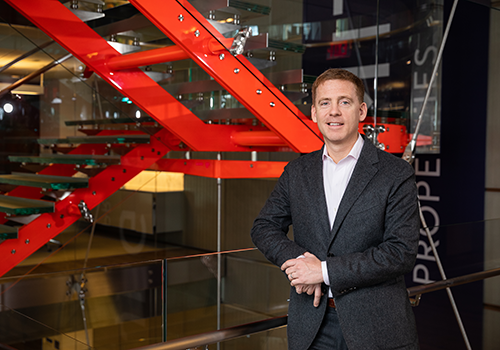
Amazon will lease 500,000 square feet of existing space in a JBG-owned building in Crystal City. The company also plans to buy two development sites owned by the REIT — PenPlace and Metropolitan Park in Pentagon City — for $294 million. Amazon has said that the campus eventually could expand to a total of 8 million square feet.
The Amazon team visited the Arlington site three times, says Kelly, to walk the neighborhoods and to learn about the company’s repositioning strategy for the 150-acre National Landing. “Their observation was that the neighborhood had a great location [right across the Potomac River from D.C.], but it felt dated,” he says.
JBG is moving to change that. The building Amazon will lease on Crystal Drive is getting a new façade, and construction begins soon on an adjacent 130,000-square-foot retail building that will house an Alamo Drafthouse Cinema and a specialty grocery store.
In 2019, Amazon expects to hire 400 people for the new headquarters, with annual salaries of $150,000.
Tim Helmig, a managing partner in Monday Properties’ D.C. office, says Amazon’s presence will change the narrative of Northern Virginia’s commercial real estate market. “Amazon’s headquarters locating in Arlington is a massive lift for the entire market,” he adds, which has suffered in recent years from the lingering effects of federal budget cuts, including sequestration and the Base Realignment and Closure (BRAC) process.
That desire for a new major employment driver saw the region pull together to land Amazon. For instance, to improve transportation, Virginia, Maryland and the District of Columbia recently agreed to fund nearly $500 million annually to shore up the region’s aging Metro subway system.
The collaborative spirit paid off, says Russ Ramsey, founder and CEO of Ramsey Asset Management and chairman of the Greater Washington Partnership, an alliance of CEOs from the Baltimore, D.C. and Richmond corridor. “If Amazon had gotten the message that this was going to be a divisive environment, they might have made a different decision.”
Ramsey says businesses in the Washington area are excited about the new growth opportunities promised by the HQ2 project, but there is concern about pressure on wages for some IT jobs. “I do think there are some CEOs who are nervous about competing with Amazon for talent,” he says, “but I think it will make everyone raise their game.”
i

